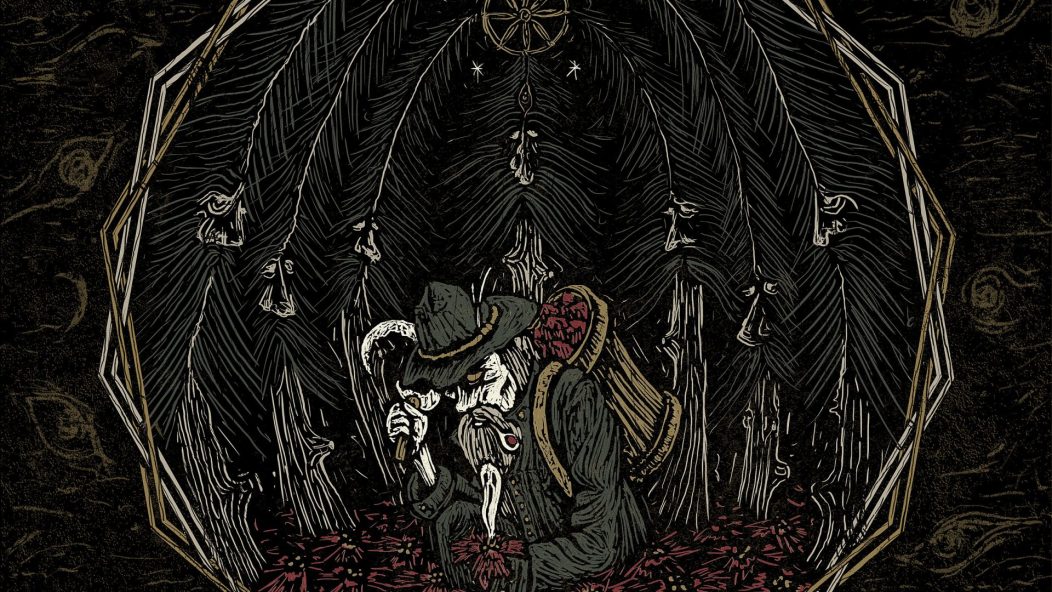
Traditions, Mysticism, and Legends on MOSAIC's "HEIMATSPUK" (Full Album Stream + Interview)
The last time we heard from Thuringian black metal and neofolk artist MOSAIC over two years ago, Secret Ambrosian Fire dazzled with a hearty fusion of its two halves, placing distinctly German neofolk against atmospheric, unusual black metal. Following the Pandemic, creator Matin van Valkenstijn took this as an opportunity to create using a different process when compared to Secret Ambrosian Fire and its predecessor Old Man’s Wyntar.
Unable to rehearse with the full band which performed on the last MOSAIC album, HEIMATSPUK is Secret Ambrosian Fire‘s creative opposite. Using more straightforward songwriting, Valkenstijn used this as an opportunity to meditate more on the traditions, mysticism, and legends which fuel the MOSAIC project. As such–and this is true for every Valkenstijn project–HEIMATSPUK is deeply entrenched in its own concepts, pushing its intended straightforwardness more into more thematic territory.
Playing a balancing act between its two halves, HEIMATSPUK is equal parts neofolk and Thuringian black metal, making it both a neofolk and a black metal album, but also neither. Following years of stylistic and conceptual meditation, Mosaic successfully makes… something else on HEIMATSPUK. Listen to the album in full and read a new interview with Martin van Valkenstijn below.
…
…
MOSAIC has played a balancing act between neo/urfolk and black metal for some time, but HEIMATSPUK shows more of a middle ground between the two. What approach did you take which made this style fusion so much more vivid this time around?
Hey Jon, thank you for having me!
HEIMATSPUK is an overall result of the Corona Pandemic. In the last two years my bandmates and I were unfortunately not able to rehearse, and we had already written a complete album and wanted to start recording. But it didn’t happen for obvious reasons.
So I started working on another album–it becameHeimatspuk. For this album I went back to the essence of MOSAIC: the combination of black metal and folk music. Since the previous album Secret Ambrosian Fire was very experimental and had many guest musicians, this time I decided to take a more straightforward approach and create the concrete opposite. For me personally, it turned out to be the album that best represents the pillars of MOSAIC: Traditions. Legends. Mysticism. and it takes the listener deep into the Thuringian forest of corpses.
Was there anything unveiled to you about MOSAIC throughout this creatively opposite project?
The creative process was very focused and effective this time. I liked the workflow a lot. Everything grew on its own.
Do MOSAIC albums normally take a longer time to compose?
I would say yes. Retrospectively I can say that Old Man’s Wyntar took four months in total, but back then I spent nearly six to eight hours per day shaping the record.
How did you look to folklore for inspiration on HEIMATSPUK?
The album is based on many regional folklore themes, such as the Hullefraan (Hulda’s servants) or Walpurgis rites.
A central theme is also the old profession of the charcoal burner. These people were not integrated into society, they lived alone in the woods and it was said that they made a pact with the devil.
On the front cover you see a charcoal burner harvesting “Blutnelken” (trans. blood carnations/blood cloves)–in Thuringian Lore those flowers only grow in areas where innocent souls were put to death.
HEIMATSPUK can be translated to “homeland haunt.” It is highly inspired and reflects my childhood and youth in the South-Thuringian Highlands, where the history of Germany of the past 100 years is centered in just a tiny village. We have old agriculture and mining there, old towers built to Bismarck’s honor, we also had a concentration camp which was part of Buchenwald, and after the Second World War it was border village of the GDR, means we still have an old border tower, and parts of the iron curtain, as well as a full ghost town–with up to ten abandoned houses. So you can imagine that this area is highly impressive, and it was totally about time to get all those things reflected and expressed.
So this goes beyond old folklore and into some more recent hauntings?
Yes, that’s right. It covers all the haunted stories of the last 100 years–and by reflecting current world events, it has a frightening topicality.
Older MOSAIC material had a tendency to look beyond the present and into more ancient tales. How do you feel these more frightening and relatable recent stories affected MOSAIC’s sound?
I wouldn’t say that in general. The reflection of the last 100 years has been omnipresent on all previous releases.
Soundwise, I wouldn’t say that it has influenced me in any way–but lyrically this topicality is quite haunting for me: a couple of songs are based on post-war poetry themes from the First World War–written by Georg Heym and Georg Trakl–and these lines can be completely transferred to the current war and that’s a feeling I honestly can’t really describe and haunts me at all.
So the haunting is a more personal connection than a folklorically-driven one?
The personal “haunting” is only caused by recent events and only for me personally as the creator of the album.
The album and the music itself is and will always be inspired by (spooky) folklore themes.
Given this alternate creative process, how do you view HEIMATSPUK in MOSAIC’s greater body of work?
HEIMATSPUK is the exact counterpart to the previous album Secret Ambrosian Fire, which was very experimental.
The basic concepts are very similar, but the approach on HEIMATSPUK is far more earthy, straightforward and reduced to black metal and folk elements.
Lyrically, it picks up right where Secret Ambrosian Fire ended–the world is in ruins and the spirits are slowly starting to revive it, so if you want to associate it with a season–as we have done on all other full-lengths so far–it would stand for the season of Spring.
What made you first take this seasonal approach with MOSAIC?
I think it all started with the fascination for the winter time. I like this season the most, mainly because of memories of my childhood and youth. The air was full of mystery, there were many lights because of the early nights and then there was the snow. That’s still my time of year–full of magic–and that led me to Old Man’s Wyntar. After that, I sorted all my memories into the season of autumn, Harvest was created–and the story continued, with the summer Secret Ambrosian Fire and now spring with HEIMATSPUK.
With all the seasons handled, do you plan on restarting the cycle?
I think we’ll work a little more freely from now on, but as always, each record will have its central leitmotif.
What do you feel will come next with this newfound creative freedom?
I am already working on a couple of concepts, one is very directly focused on nature mysticism, and one is inspired by 20th century contemporary poetry. All will have multiple seasonal aspects and elemental assignments.
Is there anything about HEIMATSPUK you would like to add, or about MOSAIC in general?
Recommended listening via quality headphones only, alone at total darkness.
…
Heimatspuk releases April 22nd on Eisenwald.
Listen to a playlist curated by Valkenstijn here.











